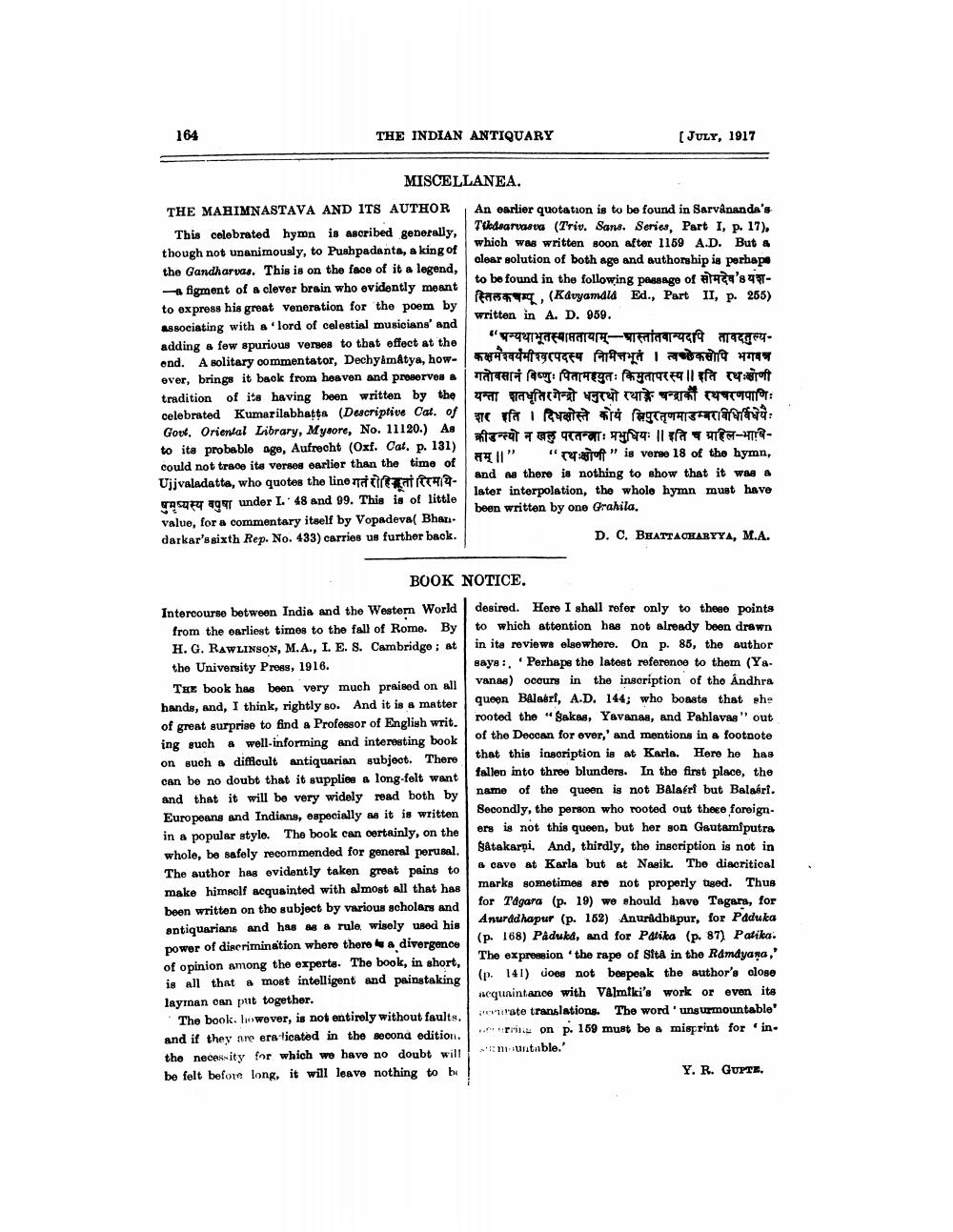________________
164
THE INDIAN ANTIQUARY
(JULY, 1917
MISCELLANEA. THE MAHIMNASTAVA AND ITS AUTHOR An earlier quotation is to be found in Sarvånanda's This colobrated hymn is ascribed generally,
Tikedsarvasva (Triv. Sans. Series, Part I, p. 17), though not unanimously, to Pushpadanta, a king of
which was written soon after 1169 A.D. But a
clear solution of both age and authorship is perhape the Gandharvas. This is on the face of it a legend,
to be found in the following passage of ataca's figment of a clever brain who evidently moant
** *, (Kavyamdia Ed., Part II, p. 255) to express his great veneration for the poem by
written in A. D. 959. Associating with a'lord of celestial musicians' and adding a few spurious verses to that effect at the
"अन्यथाभूतस्याप्ततायाम्-पास्तांतवान्यदपि तावदतुल्यond. A solitary commentator, Dechyamatya, how- 4fc664 I rene av ever, brings it back from heaven and preserves a Tarrar ras h egar: Career Il fat groft tradition of its having been written by the | यन्ता हातधृतिरगेन्द्रो धनुरथो रथाङ्गे चन्द्राकी रथचरणपाणिः celebrated Kumarilabhatta (Descriptive Cat. of
शर इति । दिधझोस्ते कोयं सिपुरतृणमाडम्बरविधिविधेयः Gout, Oriental Library, Mysore, No. 11120.) As
क्रीडन्न्यो न खलु परतन्त्राः प्रभुधियः ।। इति च पाहिल-भाषिto ite probable age, Aufrecht (Oxf. Cat. p. 131)
Il" " f" is verse 18 of the hymn, could not trace ita verses earlier than the time of ujjvaladatte, who quotes the line गतं रोहितां रिरमाय
and as there is nothing to show that it was a
later interpolation, the whole hymn must have Sacar ager under 1.. 48 and 99. This is of little
been written by one Grahila. value, for a commentary itself by Vopadeva Bhan. darkar's sixth Rep. No. 433) carries us further back.
D. C. BHATTACHARYYA, M.A.
BOOK NOTICE.
Intercourse between India and the Western World from the earliest times to the fall of Rome. By H. G. RAWLINSON, M.A., I. E. S. Cambridge ; at the University Press, 1916.
THE book has been very much praised on all hands, and, I think, rightly so. And it is a matter of great gurprise to find a Professor of English writ. ing such a well-informing and interesting book on such a difficult antiquarian subject. There can be no doubt that it supplies a long-felt want and that it will be very widely read both by Europeans and Indians, specially as it is written in a popular style. The book can certainly, on the whole, be safely recommended for general perusal. The author has ovidently taken great pains to make himaclf acquainted with almost all that has been written on tho subject by various scholars and antiquarians and has as a rule, wisely used his power of discrimination where there a divergence of opinion among the experts. The book, in short, is all that a most intelligent and painstaking layman can put together.
The book, however, is not entirely without faults. and if they are era-licated in the second edition. the necessity for which we have no doubt will be felt before long, it will leave nothing to be
desired. Here I shall refer only to these points to which attention has not already been drawn in its reviews elsewhere. On p. 85, the author saya :. Perhaps the latest reference to them (Yavanas) occurs in the inscription of the Andhra queen Balasri, A.D. 144; who boasts that she rooted the "Sakas, Yavanas, and Pahlavas" out of the Doocan for ever,' and mentions in a footnote that this inscription is at Karls. Here he has fallen into three blunders. In the first place, the name of the queen is not Balari but Balaári. Secondly, the person who tooted out there foreigners is not this queen, but her son Gautamiputra Båtakarni. And, thirdly, the inscription is not in & cave at Karla but at Nasik. The diacritical marks sometimes are not properly tiged. Thus for Tagara (p. 19) we should have Tagara, for Anuradhapur (p. 162) Anuradhapur, for Paduka (p. 168) Paduka, and for patika (p. 87) Patika. The expression the rape of Sita in the Ramdyana,' (p. 141) does not beepeak the author's close icquaintance with Valmiki's work or even its
rate translations. The word 'ung urmountable' .. pricu on p. 169 must be a misprint for in. muntable.'
Y. R. GUPTE.




